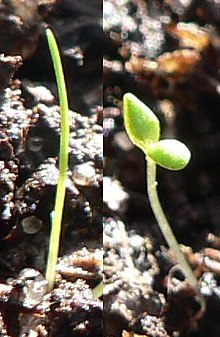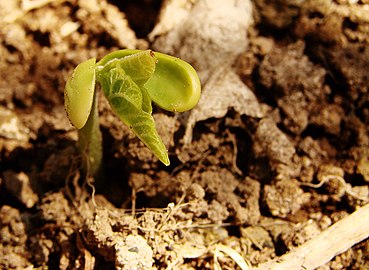Seedling


Aseedlingis a youngsporophytedeveloping out of a plantembryofrom aseed.Seedling development starts withgerminationof the seed. A typical young seedling consists of three main parts: theradicle(embryonic root), thehypocotyl(embryonicshoot), and thecotyledons(seed leaves). The two classes offlowering plants(angiosperms) are distinguished by their numbers of seed leaves:monocotyledons(monocots) have one blade-shaped cotyledon, whereasdicotyledons(dicots) possess two round cotyledons.Gymnospermsare more varied. For example,pineseedlings have up to eight cotyledons. The seedlings of some flowering plants have no cotyledons at all. These are said to beacotyledons.
Theplumuleis the part of a seed embryo that develops into the shoot bearing the firsttrue leavesof a plant. In most seeds, for example thesunflower,the plumule is a small conical structure without any leaf structure. Growth of the plumule does not occur until the cotyledons have grown above ground. This isepigeal germination.However, in seeds such as thebroad bean,a leaf structure is visible on the plumule in the seed. These seeds develop by the plumule growing up through the soil with the cotyledons remaining below the surface. This is known ashypogeal germination.
Photomorphogenesis and etiolation[edit]
Dicot seedlings grown in the light develop short hypocotyls and open cotyledons exposing theepicotyl.This is also referred to asphotomorphogenesis.In contrast, seedlings grown in the dark develop longhypocotylsand their cotyledons remain closed around the epicotyl in anapical hook.This is referred to as skotomorphogenesis oretiolation.Etiolated seedlings are yellowish in color aschlorophyllsynthesis andchloroplastdevelopment depend on light. They will open their cotyledons and turn green when treated with light.
In a natural situation, seedling development starts with skotomorphogenesis while the seedling is growing through the soil and attempting to reach the light as fast as possible. During this phase, the cotyledons are tightly closed and form theapical hookto protect the shootapical meristemfrom damage while pushing through the soil. In many plants, the seed coat still covers the cotyledons for extra protection.
Upon breaking the surface and reaching the light, the seedling's developmental program is switched to photomorphogenesis. The cotyledons open upon contact with light (splitting the seed coat open, if still present) and become green, forming the first photosynthetic organs of the young plant. Until this stage, the seedling lives off the energy reserves stored in the seed. The opening of the cotyledons exposes the shoot apical meristem and theplumuleconsisting of the firsttrue leavesof the young plant.
The seedlings sense light through the light receptorsphytochrome(red and far-red light) andcryptochrome(blue light).Mutationsin these photo receptors and theirsignal transductioncomponents lead to seedling development that is at odds with light conditions, for example seedlings that show photomorphogenesis when grown in the dark..
Seedling growth and maturation[edit]

Once the seedling starts tophotosynthesize,it is no longer dependent on the seed's energy reserves. The apical meristems start growing and give rise to therootandshoot.The first "true"leavesexpand and can often be distinguished from the round cotyledons through their species-dependent distinct shapes.[1]While the plant is growing and developing additional leaves, the cotyledons eventuallysenesceand fall off. Seedling growth is also affected by mechanical stimulation, such as by wind or other forms of physical contact, through a process calledthigmomorphogenesis.
Temperature and light intensity interact as they affect seedling growth; at low light levels about 40 lumens/m2a day/night temperature regime of 28 °C/13 °C is effective (Brix 1972).[2]Aphotoperiodshorter than 14 hours causes growth to stop, whereas a photoperiod extended with low light intensities to 16 h or more brings about continuous (free) growth. Little is gained by using more than 16 h of low light intensity once seedlings are in the free growth mode. Long photoperiods using high light intensities from 10,000 to 20,000 lumens/m2increase dry matter production, and increasing the photoperiod from 15 to 24 hours may double dry matter growth (Pollard and Logan 1976, Carlson 1979).[3][4]
The effects of carbon dioxide enrichment and nitrogen supply on the growth of white spruce andtrembling aspenwere investigated by Brown and Higginbotham (1986).[5]Seedlings were grown in controlled environments with ambient or enriched atmospheric CO2(350 or 750f1/L, respectively) and with nutrient solutions with high, medium, and low N content (15.5, 1.55, and 0.16 mM). Seedlings were harvested, weighed, and measured at intervals of less than 100 days. N supply strongly affected biomass accumulation, height, and leaf area of both species. In white spruce only, the root weight ratio (RWR) was significantly increased with the low-nitrogen regime. CO2enrichment for 100 days significantly increased the leaf and total biomass of white spruce seedlings in the high-N regime, RWR of seedlings in the medium-N regime, and root biomass of seedlings in the low-N regime.
First-year seedlings typically have high mortality rates, drought being the principal cause, with roots having been unable to develop enough to maintain contact with soil sufficiently moist to prevent the development of lethal seedling water stress. Somewhat paradoxically, however, Eis (1967a)[6]observed that on both mineral and litter seedbeds, seedling mortality was greater in moist habitats (alluvium andAralia–Dryopteris) than in dry habitats (Cornus–Moss). He commented that in dry habitats after the first growing season surviving seedlings appeared to have a much better chance of continued survival than those in moist or wet habitats, in which frost heave and competition from lesser vegetation became major factors in later years. The annual mortality documented by Eis (1967a)[6]is instructive.
Pests and diseases[edit]
Seedlings are particularly vulnerable to attack by pests and diseases[7]and can consequently experience high mortality rates. Diseases which are especially damaging to seedlings includedamping off.Pests which are especially damaging to seedlings includecutworms,pillbugs,slugsandsnails.[8]
Transplanting[edit]
Seedlings are generally transplanted,[9]when the first pair of true leaves appear. This is often known aspricking outin the UK.[10][11]A shade may be provided if the area is arid or hot. A commercially available vitamin hormone concentrate may be used to avoid transplant shock which may containthiamine hydrochloride,1-Naphthaleneacetic acidand indole butyric acid.
Images[edit]
-
A few-days-oldScots pineseedling, the seed still protecting the cotyledons
-
Seedling
-
Dicotyledon plantlet showing roots
-
Seedling ofBombaxspecies
-
Buckwheatseedling with first true leaf
See also[edit]
References[edit]
- ^"What are true leaves on vegetable seedlings".Growfully.2022-02-08.Retrieved2022-04-22.
- ^Brix, H. 1972. Growth response of Sitka spruce and white spruce seedlings to temperature and light intensity. Can. Dep. Environ., Can. For. Serv., Pacific For. Res. Centre, Victoria BC, Inf. Rep. BC-X-74. 17 p.
- ^Pollard, D.F.W.; Logan, K.T. 1976. Prescription for the aerial environment for a plastic greenhouse nursery. p.181–191inProc. 12th Lake States For. Tree Improv. Conf. 1975. USDA, For. Serv., North Central For. Exp. Sta., St. Paul MN, Gen. Tech. Rep. NC-26.
- ^Carlson, L.W. 1979. Guidelines for rearing containerized conifer seedlings in the prairie provinces. Can. Dep. Environ., Can. For. Serv., Edmonton AB, Inf. Rep. NOR-X-214. 62 p. (Cited in Nienstaedt and Zasada 1990).
- ^Brown, K.; Higginbotham, K.O. 1986. Effects of carbon dioxide enrichment and nitrogen supply on growth of boreal tree seedlings. Tree Physiol. 2(1/3):223–232.
- ^abEis, S. 1967a. Establishment and early development of white spruce in the interior of British Columbia. For. Chron. 43:174–177.
- ^Buczacki, S. and Harris, K.,Pests, Diseases & Disorders of Garden Plants,HarperCollins, 1998, p115ISBN0-00-220063-5
- ^Buczacki, S. and Harris, K.,Pests, Diseases & Disorders of Garden Plants,HarperCollins, 1998, p116ISBN0-00-220063-5
- ^"Garden".organicgardening.com.Retrieved6 April2018.
- ^"How to prick out seedlings, with Monty Don".BBC Gardeners World Magazine.20 May 2021.Retrieved21 June2021.
- ^"Pricking Out, Potting on and Transplanting: Step by Step".GrowVeg.2020.Retrieved17 October2023.
Bibliography[edit]
- P.H. Raven, R.F. Evert, S.E. Eichhorn (2005):Biology of Plants,7th Edition, W.H. Freeman and Company Publishers, New York,ISBN0-7167-1007-2






